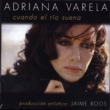|
|

Adriana Varela Cuando el río suena (When the river sounds) is a brilliant record that works in two dimensions: as a compilation of traditional rhythms and music styles of Uruguay and Argentina, and, at the same time, as a reformulation of these classical songs (some of them true anthems) with a whole lot of new arrangements which redefine the possibilities of these styles. The river of the title is the muddy Río de la Plata (River of Silver, or River Plate in the criollo -and most accepted- translation) which unites/divides Uruguay and Argentina, Montevideo and Buenos Aires. Thus, the CD has tango, candombe, murga, chamarrita, milonga, rock and an array of fusions of these mostly urban styles. The impressive deep voice of the Argentine tango chanteuse Adriana Varela is the driving force of the record. Varela was a rock fan and amateur singer who discovered tango only five years ago, after watching the movie Sur (Pino Solanas) that features iconic tango singer Roberto "Polaco" Goyeneche. The same Goyeneche became her musical "padrino," after listening to one of her first public appearances at a Buenos Aires' tango café. "I don't like girls singing tango, but Adriana ... she's something different," said Goyeneche. In just months, Varela became the most important female voice in tango of the last decades. She definitely deserved it. Her strong personality, powerful stage presence, knowledge of lunfardo (tango slang, that doesn't sound forced at all in her mouth) and singing skills (she is a professional phono-audiologist) back her up. Soon, she met Uruguayan composer, singer, guitarist Jaime Roos (49). An icon in his country and a sort of ambassador of this country's music, he is also a deep connoiseur of popular music. Roos's style is a fusion of murga (a kind of Uruguayan popular choir accompanied by drums and plates that sings socially committed songs in Carnival, with a very particular intonation), rock, candombe (Afro-Uruguayan drum rhythm), milonga and tango. The booklet includes brief, accurate definitions of the different styles presented. In this record, Roos is the artistic producer and arranger of all songs except for the classic tangos composed by legends (Homero Manzi, Celedonio Flores and Enrique Cadícamo) from the golden years of tango. Together with Varela, he recruited a team of the best Uruguayan popular musicians and experienced tango arrangers and players. The result is brilliant. Every track is surprising. The first one, Aquello (That thing), is a candombe composed by Jaime Roos. The author unfolded his own song into an uplifting, irresistible Argentinean murga. It sounds like a band marching in the street, with a tuba that provides some kind of Sargeant Pepper's dimension. Varela announces from the beginning that she will adapt to different styles without making concessions to her tango intonation. The personality of the songs is reinforced by this. Tangos are written from a masculine point of view, and Varela is not interested in providing a feminine touch to them. "I just perform what the poets wrote," she says. All the demagogy that the concept of "brotherhood" between Argentina and Uruguay implies is exorcised in this record since the first song, leaving nothing but the pure pleasure of listening to the music. The murga Don Carlos, dedicated to Gardel, is a homage to tango and a symbol of the spirit of the record. In Milongón del Guruyú, the singer makes hers the Uruguayan colors with true devotion. The same happens with the milonga Pa'l abrojal and in the candombe Ayer te vi, by Ruben Rada, here arranged to a delicious late 50's Latin jazz tune. The idea in the tangos was to reproduce the climate of the "boliches" (cafes) of the 40's and 50's and the music is stripped of all makeup. De barro, typical 40's composition, is only accompanied by a guitar. Madamme Ivonne and Pa' lo que te va a durar are played by the classical tango trios (piano, double bass, and bandoneón - a large accordion), and Mano a Mano includes just the bandoneón and double bass. On the other side, Garúa is played by the largest tango ensemble in the world: The Philarmonic Orchestra of Montevideo. A record that includes songs written 70 years ago and still sounds new, foundational, must be considered a rare jewel. This is the case. Copyright © 1999 Javier Lyonnet
|
| © 2011 Luna Kafé |